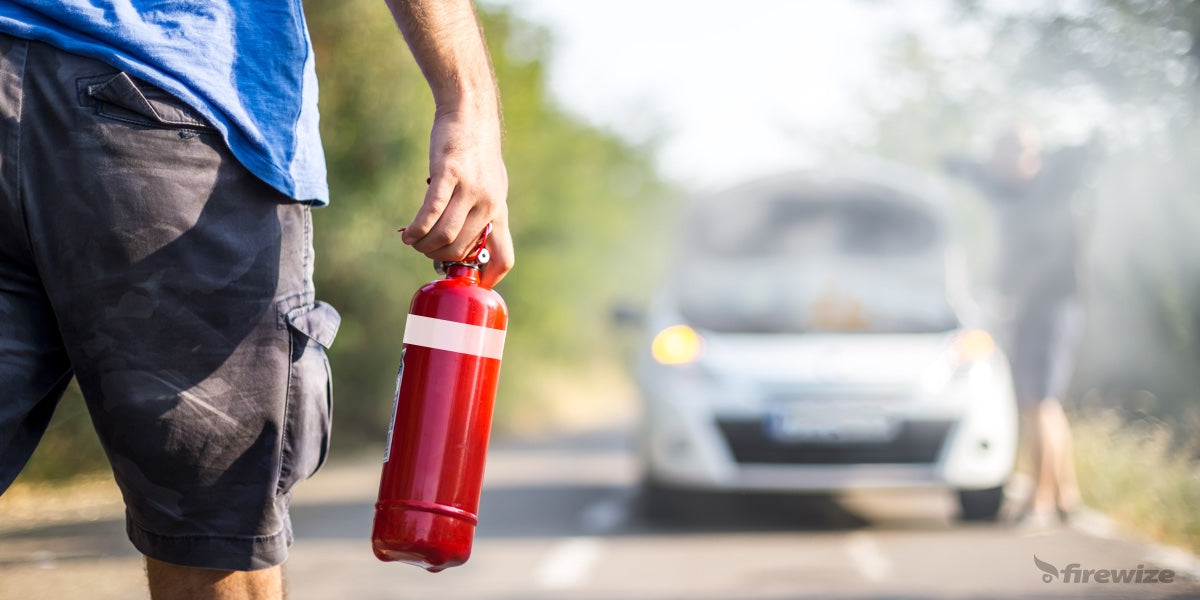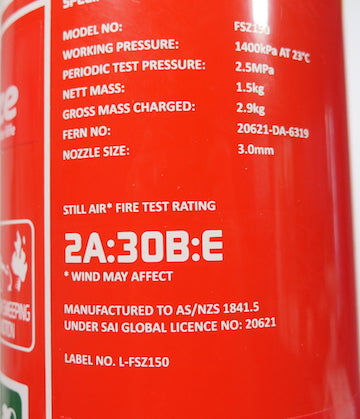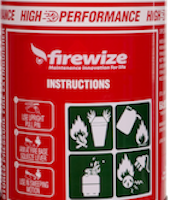
Fire Extinguishers for the Home
In Australia we differentiate the different types of fire extinguishers by using an established colour code convention. These colour codes are intended to help you select the right fire extinguisher for the right type of fire. To make this easier, as professionals we select and place fire extinguishers in the vicinity of the risk (but not too close) for easy access and use.
You might think that choosing the nearest fire extinguisher to a fire is the right choice (and in many cases it may be) however selecting the wrong type of fire extinguisher could have disastrous ramifications.

To avoid confusion and minimise the risks from inappropriate fire extinguisher selection, we have selected a range of fire extinguishers that are universally acknowledged for broad application and use.
In most family homes, we recommend a Dry Chemical Powder fire extinguisher with an AB(E) rating and a fire blanket.
The letters AB(E) relate to the types of fires that the fire extinguisher can be used on as follows;
| Class A |
A Class A fire is one where the fuel (or combustible material) typically has a carbon basis. Examples of these types of fuel include; wood, paper, timber, charcoal, some plastics and textiles etc. |
| Class B |
A Class B fire is one where the fuel is a flammable liquid. Examples include; paint, thinners, petrol, diesel, methylated spirits, alcohol, etc. |
| Class E |
A Class E fire involves live electrical equipment, which require the use of electrically non conductive extinguishing agents. Examples include; electrical switchboards, whitegoods, electrical appliances. |
There are other types of fires that have different classifications such as;
- Class C - Flammable gasses
- Class D - Flammable metals
- Class F - Cooking Oil / Deep fat fryers
While fires with these classifications could occur in the family home, they are not typical.
Fire extinguishers are also colour coded and labeled so users can identify the classes of fire on which the extinguisher will be effective. The marking system combines a colour band and pictograph of recommended application of the fire extinguisher.
A Dry Chemical Powder Fire Extinguisher is easily identifiable from its RED body colour and white band. There are TWO common types of Dry Chemical Powder, they include the BE Class and the AB(E) Class. For the family home, we recommend the AB(E) classification of Dry Chemical Powder Portable Extinguishers.
In a typical family home, when paired with appropriate signage users should be confident in the correct selection and use of the fire extinguisher and/or fire blanket for most types of small fires.
Selecting the right fire extinguisher
We offer a Dry Chemical Powder AB(E) type fire extinguisher selection of three different capacities for the home;
- 1.0Kg AB(E) Dry Chemical Powder Fire Extinguisher
- 1.5Kg AB(E) Dry Chemical Powder Fire Extinguisher
- 2.5Kg AB(E) Dry Chemical Powder Fire Extinguisher
Each of these have their place in the family home, car, caravan or boat. The larger the capacity of the fire extinguisher, the greater its ability to control and suppress a fire. Choosing the right size fire extinguisher gets down to the building use, size and possible fire risk. Larger sizes are available with increased performance for those bigger properties.
Benefits of the AB(E) Dry Chemical Powder Fire Extinguisher
The AB(E) Dry Chemical Powder Fire Extinguisher has many benefits over alternative fire extinguishers in the family home, these include;
- Wide range of applications; including Class A, Class B and Class E fires.
- Not electrically conductive, making it ideal for fires involving live electrical equipment.
- A Dry Chemical Powder fire extinguisher is very economical.
- Depending on the capacity and rating of the fire extinguisher, a Dry Chemical Powder fire extinguisher is very versatile and can be used for small and large fires.
What do we use in our family home?
We use the 2.5Kg AB(E) Dry Chemical Powder Fire Extinguisher. It is located in our laundry approximately 7m from the kitchen and centrally accessible from all other areas of the home.
How to use a Dry Chemical Powder Fire Extinguisher
A Dry Chemical Powder Fire Extinguisher can be used like most other fire extinguishers during a fire. The common PASS mnemonic is universally applicable;
- P = Pull the Pin
- A = Aim The Fire Extinguisher (Hose or Nozzle) at the base of the fire
- S = Squeeze the lever slowly
- S = Sweep from side-to-side
Also in News

What is fire classification and performance rating and why is it so important?
The rating of a fire extinguisher is a measure of the relative performance of a fire extinguisher given its classification. The rating is a numerical system and indicates its capacity to extinguish a fire.
Read More
Best Dry Powder Fire Extinguisher
A new addition to the dry powder fire extinguisher range with added performance: ABC(E) - Carbonaceous Fire, Flammable Liquid, Gas Fire and Electrical.
The new range of High Performance ABC(E) 4.5Kg dry powder fire extinguishers have an increased performance fire rating of 6A:80:C:E. With the High Performance ABC(E) 9.0Kg performance rating of 10A:80B:C:E.

Hand Picked Fire Extinguishers, Blankets and Smoke Alarms
We created a list of products that we use in our own family homes. Our selection criteria includes quality, reliability, compliance, value, usage, reputation and support. Our product range has been hand picked to suit your family, home, caravan, car, and boat.
Read More
